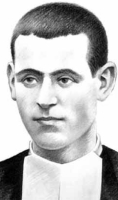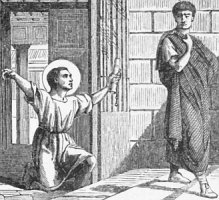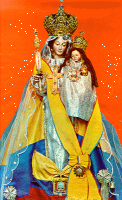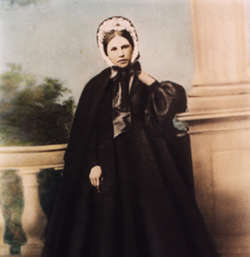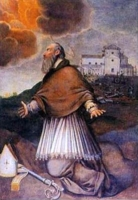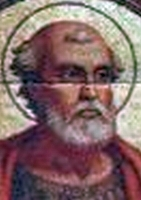St. Lucretia
Feastday: November 22
Death: 306
Saint Lucretia is a revered figure in Roman history and Christianity, known for her unwavering virtue and tragic fate. She is traditionally believed to have lived in ancient Rome during the reign of the last king, Lucius Tarquinius Superbus.
The Legend of Lucretia
The legend of Lucretia is recounted by the Roman historian Livy in his "Ab Urbe Condita Libri." According to the story, Lucretia was a noblewoman of exceptional beauty and virtue, married to the respected nobleman Lucius Tarquinius Collatinus. Her peaceful life was shattered when she was assaulted by Sextus Tarquinius, the son of the tyrannical king.
Overwhelmed by shame and grief, Lucretia summoned her father Spurius Lucretius Tricipitinus and her husband Collatinus, along with their trusted friend Lucius Junius Brutus. She revealed the heinous act of Sextus Tarquinius and, after extracting an oath of vengeance from the men, took her own life by stabbing herself.
The tragic death of Lucretia sparked widespread outrage and rebellion among the Roman people. Brutus, who had witnessed Lucretia's plight and vowed justice, led the uprising that eventually overthrew the Tarquin dynasty and established the Roman Republic.
Veneration as a Saint
Lucretia's unwavering virtue and her tragic demise made her a symbol of female purity and courage. She was revered as a saint in early Christian tradition, and her story continues to be celebrated in art, literature, and historical accounts.
Representation in Art
The story of Lucretia has been a popular subject for artists throughout history. She is often depicted in paintings and sculptures as a beautiful and virtuous woman, sometimes shown at the moment of her suicide or surrounded by mourners. Some notable representations include:
Blessed Tommaso Reggio
Profile
Son of Angela Pareto and the Marquis of Reggio. Tommaso felt a call to the priesthood at age 20; he studied and was ordained on 18 September 1841. Vice-rector of the seminary in Genoa, Italy at age 25. Rector of the seminary in Chiavari, Italy.
Helped found The Catholic Standard, the first Catholic newspaper. In 1865 the Standard and 25 other papers supported slates of Catholic candidates, hoping to found a Catholic political party. However, in 1874 Catholics were told they could not vote, and Father Tommaso closed the paper.
Bishop of Ventimiglia, Italy in 1877; the diocese was so poor, Tommaso had to travel to his parishes on a mule. He opened new parishes, organized three synods and liturgical revival, set up teaching programs. Prayed every night from 3 to 6 a.m., and never let anyone see him worry. Founded the Sisters of Saint Martha in 1878, a congregation devoted to caring for the poor.
Following an earthquake in 1887, he worked with the injured in the rubble, and ordered his priests to use all resources to help the displaced. Founded orphanages at Ventimiglia and San Remo, Italy to house, educate, and train children who had lost their families in the quake.
In 1892 he asked the Pope to relieve him of his duties; instead, on 11 July the Pope appointed him archbishop of Genoa, Italy. The city was politically complex and tense, but his humble, open, pious generosity won over many, and people in and out of the Church came to him with problems. Set up a network to help immigrants, worked for Catholic lay associations, supported limited work hours and complete days off for working people - radical notions in those days. He died while on pilgrimage with a group of other bishops and clergy.
Born
8 January 1818 at Genoa, Italy
Died
• afternoon of 22 November 1901 at Triora, Imperia, Italy of natural causes
• funeral held at the Cathedral of San Lorenzo, Genoa, Italy
Beatified
• 3 September 2000 by Pope John Paul II
• the beatification miracle involved the healing of Pabla Valdenegro Romero, a six-year-old girl, of Guillain-Barré Syndrome (polyradiculoneuritis), with albumin-cytological dissociation, ascending paralysis with cranial nerve involvement, quadriplegia, prolonged respiratory failure, two cardiac arrests, subcutaneous emphysema, and other infectious pulmonary complications in Valpariso, Chile, on 10 November 1985
Saint Cecilia
புனிதர் செசிலியா
கன்னியர் மற்றும் மறைசாட்சி:
பிறப்பு: கி.பி. இரண்டாம் நூற்றாண்டு
ரோம், இத்தாலி
இறப்பு: நவம்பர் 22, 230
சிசிலி
ஏற்கும் சமயம்:
ரோமன் கத்தோலிக்க திருச்சபை
லத்தீன் கத்தோலிக்க திருச்சபை
கிழக்கு கத்தோலிக்க திருச்சபை
ஆங்கிலிக்கன் திருச்சபை
கிழக்கு மரபுவழி திருச்சபை
முக்கிய திருத்தலம்:
தூய செசிலியா தேவாலயம், ட்ரஸ்டேவெர், ரோம்
பாதுகாவல்:
பாசுரங்கள் (Hymns), இசைக்கலைஞர்கள், கவிஞர்கள், "ஒமாஹா பேராயம்" (Archdiocese of Omaha), அர்ஜென்ட்டினா (Argentina), “மர் டெல் ப்லடா” – ஒரு அர்ஜென்டினிய நகரம் (Mar del Plata – An Argentinian City), ஃபிரான்ஸ் (France)
புனிதர் செசிலியா, இசைக்கலைஞர்களின் பாதுகாவலர் ஆவார். தமது திருமணத்தின்போது, தமது மனதுக்குள் கடவுளிடம் பாடினார் என்று எழுதி வைக்கப்பட்டுள்ளது. திருப்பலியின்போது, பெயர் சொல்லி நினைவு கூறப்படும் (அன்னை கன்னி மரியாளைத் தவிர்த்து) ஏழு பெண்களுள் செசிலியாவும் ஒருவர் ஆவார்.
அவரது சரித்திர விவரங்கள் கற்பனையாக இருப்பதாகத் தோன்றினாலும், அவரது இருப்பு மற்றும் மறைசாட்சியம், ஒரு வரலாற்று உண்மை என்றே கருதப்படுகிறது. ரோம் நகரின் “டிரஸ்டேவியர்” (She is said to have been beheaded with a sword) பகுதியிலுள்ள, நான்காம் நூற்றாண்டில் நிறுவப்பட்ட, “தூய செசிலியா” (Santa Cecilia) எனும் ஒரு ஆதி கிறிஸ்தவ ரோமன் தேவாலயத்தின் பக்கத்திலயே செசிலியா வசித்துவந்ததாகவும் கூறப்படுகிறது. பல்வேறு இசையமைப்புகள் அர்ப்பணிக்கப்பட்டுள்ள புனிதர் செசிலியாவின் நினைவுத் திருநாள், நவம்பர் மாதம் 22ம் நாள் கொண்டாடப்படுகின்றது.
ரோம் நகரின் பிரப்புக்கள் குடும்பமொன்றினைச் சேர்ந்த பெண்ணான செசிலியா, தமது கணவரான “வலேரியன்” (Valerian), கணவரின் சகோதரரான “’டிபர்ஷியஸ்” (Tiburtius), மற்றும் “மேக்சிமஸ்” (Maximus) எனும் பெயர்கொண்ட ரோம சிப்பாய் ஆகியோர் “பேரரசர் அலெக்சாண்டர் செவெரஸ்” (Emperor Alexander Severus) காலத்தில், சுமார் கி.பி. 230ம் ஆண்டில் மறைசாட்சியராக மரித்தனர்.
ஓரு ரோமன் கத்தோலிக்க குடும்பத்தில் பிறந்து, கிறிஸ்துவுக்காக வாழ வேண்டுமென்று சிறுவயதிலிருந்தே விரும்பியவர் புனிதர் செசிலியா ஆவார். இளம் வயதிலேயே தன் கன்னிமையை கடவுளுக்கு அர்ப்பணம் செய்ததால் திருமணம் செய்துகொள்ள விரும்பவில்லை. ஆனால் இவரின் பெற்றோர் செசிலியாவை “வலேரியன்” (Valerian) என்ற “பாகன் இன பிரபுத்துவ” (Pagan Nobleman) இளைஞர் ஒருவருக்கு திருமணம் செய்ய நிச்சயம் செய்தனர். ஆனால் அதனை செசிலியா பெரிதாக கருதாமல் தன்னுடைய ஆன்மீக காரியங்களில் மட்டுமே கருத்தாக இருந்தார். வலேரியனுடன் திருமணம் செய்யவிருப்பதை வெறுத்தார். இருப்பினும் பெற்றோரை எதிர்த்து அவரால் ஒன்றும் செய்ய இயலாமல் தவித்தார்.
திருமண நாள் வந்தது. இவரின் பெற்றோர் இவருக்கு திருமண உடையை அணிவித்தபோது இதயம் வலித்தவராய், தன்னை முழுவதும் தன் மணவாளன் இயேசுவிடம் ஒப்படைத்து செபித்தார். பெற்றோர் இவரை கணவரிடம் ஒப்படைத்தபோது, தான் கடவுளிடம் கொடுத்த கற்பு என்னும் வார்த்தைப்பாட்டை உன்னிடம் இழக்கமாட்டேன் என்று உறுதியாக தெளிவாக கூறினார். தான் கடவுளுக்கு மட்டுமே சொந்தமானவள் என்பதை தைரியமாக எடுத்துக்கூறினார்.
அவள் தன் கணவனை நோக்கி, "கடவுளின் தூதர் ஒருவர் என் கற்புக்கு காவலராய் இருக்கிறார். எனவே, என்னுடைய கன்னிமைக்கு தீங்கிழைக்கக்கூடிய அல்லது கடவுளது கோபத்தை உம்மீது வரச்செய்யும்படியான எதையும் செய்ய நீர் முயற்சிக்கலாகாது" என்றாள்.
வலேரியன், செசிலியா சொல்வது உண்மையா என்பதை சோதிக்கும் நோக்குடன், "கடவுளின் அந்தத் தூதரை நான் பார்ப்பேனானால் இயேசு கிறிஸ்துவை விசுவசிப்பேன்" என்றார்.
செசிலியா அதை நிரூபிக்க வேண்டுமானால், வலேரியன் முதலில் திருத்தந்தை “அர்பனிடம்” (Pope Urban) சென்று திருமுழுக்குப் பெற்று வருமாறு கூறினார். செசிலியாவின் வார்த்தைகளுக்கு சம்மதித்து, அவரும் திருமுழுக்கு பெற்றார். அவர் திருமுழுக்கு பெற்ற நாளன்றே வானதூதர் ஒருவர் அவர் முன்னின்று செசிலியாவுக்கு ரோஜா மலர் கிரீடம் அணிவித்து வாழ்த்தியதைக் கண்டார்.
அதன்பின்னர் வலேரியன் செசிலியாவை அவரின் விருப்பப்படி வாழ விட்டுவிட்டார். செசிலியாவை நம்பினார். வலேரியன் தன் குடும்ப உறுப்பினர்கள் அனைவரையும் கத்தோலிக்க திருச்சபைக்கு மனமாற்றினார். அவர்கள் அனைவரும் மனமாற்றம் பெற்ற நாளிலிருந்து செசிலியாவிற்கு பணிந்து இரவும் பகலும் அவருக்கு பணிவிடை புரிந்தனர்.
செசிலியா, தான் மணந்த வலேரியனின் உதவியுடன் கடவுளின் அன்பை உணர்ந்து வாழ்ந்தார். ஏழைகளின் மீது இரக்கம் காட்டி, அனைவரையும் சமமாக அன்பு செய்தார். இறைவனை இரவும் பகலும் பாடல்களால் போற்றிப் புகழ்ந்தார்.
இவரின் பக்தியைக் கண்ட எதிரிகளில் ஒருவனான அரசு அதிகாரியான "டுர்சியஸ் அல்மசியஸ்" (Turcius Almachius) என்பவன் செசிலியாவை கூரிய குறுவாளால் மூன்றுமுறை அவரது கழுத்திலேயே குத்தினான். மரணத்தின் விளிம்பில் வீழ்ந்த செசிலியா, தம்மை தேவாலயத்திற்கு இட்டுச்செல்லுமாறு திருத்தந்தையிடம் வேண்டினார். அதன்பின் மூன்றே நாட்கள் உயிர்வாழ்ந்த செசிலியா மறைசாட்சியாக உயிர் துறந்தார்.
புனிதர் “கல்லிஸ்டஸ்” (Catacombs of St. Callistus) கல்லறை நிலத்தில் அடக்கம் செய்யப்பட்ட செசிலியாவின் உடல் 'ட்ரஸ்ட்டேவேர்" எனும் இடத்திலுள்ள "தூய செசிலியா” தேவாலயத்திற்கு (Church of Santa Cecilia in Trastevere) மாற்றப்பட்டது. கி.பி. 1599ம் ஆண்டில், அவரது உடல் அழிந்துபோகாமல் உறங்குவது போல் காணப்பட்டதாக கூறப்படுகிறது.
இவர் கிறிஸ்தவ பெண்கள் அனைவருக்கும் சிறந்ததோர் எடுத்துக்காட்டாக திகழ்ந்தார். கிறிஸ்துவின் மீது கொண்ட அன்புக்காக கன்னிமை காத்து வாழ்ந்தார். அவருக்காக மறைசாட்சியாகவும் மரித்தார்.
Also known as
Cecily, Cicilia
Profile
Cultivated young patrician woman whose ancestors loomed large in Rome's history. She vowed her virginity to God, but her parents married her to Valerian of Trastevere. Cecilia told her new husband that she was accompanied by an angel, but in order to see it, he must be purified. He agreed to the purification, and was baptised; returning from the ceremony, he found her in prayer accompanied by a praying angel. The angel placed a crown on each of their heads, and offered Valerian a favor; the new convert asked that his brother be baptised.
The two brothers developed a ministry of giving proper burial to martyred Christians. In their turn they were arrested and martyred for their faith. Cecilia buried them at her villa on the Apprian Way, and was arrested for the action. She was ordered to sacrifice to false gods; when she refused, she was martyred in her turn.
The Acta of Cecilia includes the following: "While the profane music of her wedding was heard, Cecilia was singing in her heart a hymn of love for Jesus, her true spouse." It was this phrase that led to her association with music, singers, musicians, etc.
Died
• martyred in the 3rd century
• suffocated for a while, and when that didn't kill her, she was beheaded
• her grave was discovered in 817, and her body removed to the church of Saint Cecilia in Rome
• the tomb was opened in 1599, and her body found to be incorrupt
Blessed Anna Kolesárová
Also known as
Anka Kolesárová
Profile
Daughter of Ján "Hruska" Kolesár and Anna (née Kusnírová), she was born into a pious farming family and baptized at the age of one day. Anna's mother died when the girl was ten years old, and she did her best to run the household for her father and brother, Michal. When Russian soldiers were liberating her area of Slovakia from Nazi occupation near the end of World War II, local families hid from them due to their rough, violent reputation, and to avoid the combat that went on around their villages. On 22 November 1944, Anna was discovered by a drunken Red Army soldier who made her cook for him, and then demanded sex. She refused and ran to her father and brother, but was gunned down by the soldier. Martyr.
Born
14 July 1928 in Vysoká nad Uhom, diocese of Kosice, Czechoslovakia (in the modern Slovak Republic)
Died
• shot in the chest and the face with a rifle on 22 November 1944 in Pavlovce nad Uhom, Kosice, Slovak Republic
• buried in a shallow grave on the evening of the next day by her family who still had to spend most of their time in hiding due the combat around them
• re-buried and given proper funeral rites by Father Anton Lukác on 29 November 1944; he immediately begin conducting his own preliminary investigation into her Cause for Canonization
• during the period of Communist Czechoslovakia, mention of the incident and gatherings at her grave were prohibited
• since the fall of the Communist government, her grave has become a pilgrimage site for young people including the Catholic youth organization Domcek which is dedicated to her memory
Beatified
1 September 2018 by Pope Francis
Blessed Salvatore Lilli
Also known as
Salvatore of Cappadocia
Profile
Son of Vincenzo and Annunziata Lilli. Joined the Franciscans in 1870, making his vows on 6 August 1871. Studied at the Franciscan seminary in the Holy Lands. Ordained in Bethlehem on 6 April 1878. Missionary in Jerusalem for two years. Missionary to Marasco, Armenia in 1880. In addition to preaching the faith he built schools, clinics, and homes for the abandoned, and taught modern hygiene and sanitation in the remote villages. Worked endlessly with the sick during a cholera epidemic in 1891. Missionary to Mujuk-Deresa, Armenia in 1894. In 1895 the area was occupied by Islamic Turks who captured Salvatore and several fellow Franciscans. They were tortured and ordered to convert; they all refused. One of the Martyrs of Armenia.
Born
19 June 1853 at Cappadocia, Aquila, Italy
Died
stabbed with a lance on 22 November 1895 near the Zihun River in Mujuk-Dersi, Armenia (in modern Turkey)
Beatified
3 October 1982 by Pope John Paul II
Saint Pedro Esqueda Ramírez
Additional Memorial
21 May as one of the Martyrs of the Mexican Revolution
Profile
Priest. Vicar-general of the diocese of San Juan de los Lagos, Mexico. Discerning a need for religious education for children, he founded catechetical study centers. Martyr.
Born
29 April 1887 in San Juan de los Lagos, Jalisco, diocese of San Juan de los Lagos, Mexico
Died
• shot three times on 22 November 1927 in Teocaltitán, Jalisco, Mexico
• buried at the church of San Juan Bautista, San Juan de los Lagos, Jalisco, diocese of San Juan de los Lagos, Mexico
Canonized
21 May 2000 by Pope John Paul II
Blessed Francisco Lahoz Moliner
Also known as
Brother Bertrán Francisco
Profile
Baptized at the age of one day. Joined the Brothers of the Christian Schools at Cambrils, Spain on 10 August 1925, making his vows on 2 February 1929. Teacher and catechist of novices. Imprisoned and martyred in the Spanish Civil War.
Born
15 October 1912 in Campos, Teruel, Spain
Died
• 22 November 1936 in Picadero de Paterna, Valencia, Spain
• buried in a common grave in Valencia
Beatified
11 March 2001 by Pope John Paul II
Blessed Julián Torrijo Sánchez
Also known as
Brother Elías Julián
Profile
Baptized at the age of one day. Joined the Brothers of the Christian Schools in Cambrils, Spain on 13 November 1916. Teacher and youth minister at a series of schools beginning in 1920. Imprisoned and martyred in the Spanish Civil War.
Born
17 November 1900 in Torrijo del Campo, Teruel, Spain
Died
22 November 1936 in Picadero de Paterna, Valencia, Spain
Beatified
11 March 2001 by Pope John Paul II
Saint Philemon
Profile
First century Christian convert at Colossae, Phrygia, brought to the faith by Saint Paul the Apostle. Married to Saint Apphia. Subject of Paul's canonical Epistle to Philemon in which he asks Philemon to accept back the runaway slave Saint Onesimus, receiving him as a brother Christian; tradition says that he freed the slave. Martyred with Saint Apphia.
Died
stoned to death in the 1st century at Colossae, Phrygia
Saint Amphilochius of Iconium
Profile
Successful 4th-century lawyer who gave up the worldly life to live as a hermit. Bishop of Iconium. Worked with Saint Basil to govern the Church in Cappadocia. Friend of Saint Gregory of Nazianzen who wrote highly of him. Attended the Council of Constantinople in 381. Worked with Saint Jerome. Supported the theological teaching on the Divinity of the Holy Ghost. Opposed Macedonius. Presided over the Council at Sida in Pamphylia.
Saint Ananias of Arbela
Also known as
• Ananias of Erbel
• Ananio of...
Profile
Saint Ananias of Arbela, also known as Ananias the Persian, was a Christian martyr who lived in Arbela, Persia (present-day Erbil, Iraq) during the 4th century AD. He is venerated as a saint in the Catholic Church, the Eastern Orthodox Church, and the Syriac Church.
Life and Martyrdom
According to tradition, Ananias was a layperson who was known for his piety and his devotion to his faith. During the reign of the Persian king Shapur II, who was fiercely persecuting Christians, Ananias was arrested and brought before the authorities for refusing to renounce his Christian faith.
Ananias was subjected to torture and was repeatedly urged to abandon his beliefs, but he remained steadfast in his faith. Eventually, he was sentenced to death by scourging and was then beheaded.
Feast Day and Veneration
Saint Ananias of Arbela's feast day is celebrated on November 22. He is particularly venerated in the Syriac Church, where he is considered one of the most important martyrs of the Persian persecution.
Ananias is also remembered in the Catholic Church and the Eastern Orthodox Church. He is a symbol of courage and perseverance in the face of persecution, and his story is an inspiration to Christians around the world.
Representation in Art
Saint Ananias is often depicted in art as a young man with a beard. He is sometimes shown holding a palm branch, which is a symbol of martyrdom.
Died
• scourged and left for dead on the side of the road in 345 in Arbela, Persia (in modern Iran)
• found by local Christians and taken home where he he died the next day from his injuries
Blessed Ferran Llovera Pulgsech
Also known as
Father Ferran Maria
Profile
Blessed Ferran Llovera Pulgsech was a Spanish Catholic priest and martyr. He was born in Barcelona, Spain, on July 13, 1874. He entered the Society of Jesus in 1893 and was ordained a priest in 1907.
Llovera was a gifted preacher and teacher. He was also a passionate advocate for social justice. He worked tirelessly to improve the lives of the poor and marginalized.
During the Spanish Civil War, Llovera was arrested by the Republican government for his religious beliefs. He was tortured and executed on August 25, 1936.
Llovera was beatified by Pope Francis on October 13, 2022.
Early Life and Vocation
Ferran Llovera Pulgsech was born in Barcelona, Spain, on July 13, 1874. He was the son of a wealthy businessman.
Llovera was a bright and studious child. He attended the Jesuit school in Barcelona, where he excelled in his studies.
In 1893, Llovera entered the Society of Jesus. He studied philosophy and theology at the Jesuit seminary in Manresa, Spain.
Llovera was ordained a priest in 1907. He was assigned to the Jesuit parish of San Felipe Neri in Barcelona.
Preaching and Teaching
Llovera was a gifted preacher and teacher. He was known for his clear and concise explanations of the Catholic faith.
Llovera also had a deep love for the poor and marginalized. He worked tirelessly to improve their lives.
Llovera founded a school for poor children in Barcelona. He also helped to establish a soup kitchen and a home for the elderly.
Martyrdom
The Spanish Civil War broke out in 1936. The Republican government, which was hostile to the Catholic Church, arrested and executed thousands of priests and religious.
Llovera was arrested on August 25, 1936. He was tortured and executed the same day.
Llovera's body was thrown into a mass grave. His remains were eventually recovered and reburied in the Jesuit cemetery in Barcelona.
Beatification
Llovera's cause for beatification was opened in 1952. He was declared a Servant of God in 1991.
Llovera was beatified by Pope Francis on October 13, 2022.
Born
19 March 1902 in Orfans, Girona, Spain
Died
22 November 1936 in Montjuïc, Barcelona, Spain
Beatified
28 October 2007 by Pope Benedict XVI
Saint Benignus of Milan
Also known as
Benigno
Profile
Educated in Rome, Italy. Archbishop of Milan, Italy c.470, serving during a period of barbarian invasion.Saint Benignus of Milan (Italian: Benigno) was Archbishop of Milan from 465 to 472. He is honored as a Saint in the Catholic Church
Life
Almost nothing is known about the life and episcopate of Benignus. He was probably born to a noble family of Milan and studied in Rome. He was elected bishop of Milan in 465, and he participated to a council which is identified by scholars as the Roman synod of November 19, 465, held in the Basilica di Santa Maria Maggiore under the presidency of Pope Hilarius.
Episcopate
During his episcopate, Milan was under the rule of the Heruli, a Germanic tribe led by Odoacer. The Heruli were Arian Christians, and they persecuted the Catholic population of Milan. Benignus worked tirelessly to protect his flock from the Arian heresy and to promote the Catholic faith.
Death
Benignus died in 472. He is buried in the Basilica di Sant'Ambrogio in Milan.
Veneration
Benignus was venerated as a saint shortly after his death. His feast day is celebrated on September 20. He is the patron saint of the city of Malcesine, Italy.
Died
c.477 in Milan, Italy of natural causes
Saint Apphia
Profile
Saint Apphia, also known as Apphia of Colossae, was a Christian martyr who lived in the 1st century AD. She is counted among the Seventy Apostles sent out by Jesus Christ and is venerated as a saint in the Orthodox Church.
Life and Martyrdom
Saint Apphia's life is described in the New Testament, specifically in the Epistle to Philemon. She is mentioned as the wife of Philemon, a wealthy Christian who lived in Colossae, a city in Asia Minor. Philemon and Apphia opened their home to the apostle Paul and his companions, providing them with hospitality and support during their missionary journeys.
According to tradition, Saint Apphia was a devout and virtuous woman who was known for her piety and her unwavering faith. She was a pillar of strength for her husband Philemon and played a vital role in spreading the Christian message in Colossae.
During a time of persecution against Christians, Saint Apphia and her husband Philemon were arrested and brought before the authorities for their beliefs. They were offered the opportunity to renounce their faith and save their lives, but they refused. Instead, they boldly confessed their love for Jesus Christ and were sentenced to death.
Saint Apphia and her husband Philemon were martyred together, along with Archippus, a fellow Christian who was also part of their household. Their exact date of martyrdom is unknown, but it is believed to have occurred in the late 1st century AD.
Veneration
Died
stoned to death in the 1st century at Colossae, Phrygia
Saint Maurus of North Africa
Profile
Raised in a Christian family in North Africa. Immigrant to Rome, Italy. Martyred in the persecutions of Emperor Numerian.
Saint Deyniolen the Younger
Also known as
Daniel, Dayniol, Deiniol, Deyniolin
Profile
Saint Deyniolen the Younger (Welsh: Deiniol Fychan) was a 6th-century Welsh abbot and saint. He is the patron saint of Bangor Cathedral and is commemorated on November 22.
Life
Deyniolen was born into a noble family in Gwynedd, Wales. He was educated at the monastery of Bangor-Is-Coed under the tutelage of Saint Cadfan, a prominent Welsh saint and abbot. Deyniolen was known for his piety, his devotion to study, and his love for the poor and marginalized.
After completing his education, Deyniolen was ordained a priest and established a monastery at Bangor-on-Dee (Bangor Mon), which became a renowned center of learning and religious life in Wales. Deyniolen served as the abbot of Bangor Mon for many years, attracting a large community of monks and students who sought his guidance and spiritual wisdom.
Deyniolen was a gifted preacher and teacher. He was known for his clear and concise explanations of the Christian faith, and he was able to connect with people from all walks of life. He was also a compassionate and caring leader, who devoted his life to the service of God and his people.
Deyniolen died in the late 6th century. He is buried at Bangor Mon Cathedral, where his tomb remains a place of pilgrimage for many Welsh Christians.
Veneration
Deyniolen is venerated as a saint in the Catholic Church, the Orthodox Church, and the Anglican Church. His feast day is celebrated on November 22. He is the patron saint of Bangor Cathedral and is considered a protector of sailors and travellers.
Deyniolen is often depicted in art as an abbot wearing a white robe and miter. He is sometimes shown holding a crozier or a book, symbols of his office and his devotion to learning.
Died
621
Saint Pragmatius of Autun
Also known as
Prammazio, Pragmazio
Profile
Saint Pragmatius of Autun (French: Pragmace; fl. c. 520) was a Bishop of Autun in the 6th century. He was a friend of Sidonius Apollinaris and Avitus of Vienne, and he participated in at least one of the councils of his time. He is venerated as a saint by the Roman Catholic Church; his feast day is celebrated on 22 November.
Life
Very little is known about Saint Pragmatius of Autun's early life or education. He is first mentioned in historical records in the early 6th century, when he served as a deacon to Saint Aprunculus, the Bishop of Autun. After Aprunculus's death in 512, Pragmatius was elected to succeed him as Bishop of Autun.
As Bishop of Autun, Pragmatius played an important role in the religious and political life of Gaul during the 6th century. He was a close friend and confidant of Sidonius Apollinaris, a prominent Gallo-Roman poet and bishop of Clermont, and he corresponded with him on a regular basis. Pragmatius also maintained close ties with Avitus of Vienne, another important figure in the Gallo-Roman episcopate.
In 515, Pragmatius participated in the Council of Epaone, which was convened to address the Arian heresy. The council condemned Arius's teachings and reaffirmed the orthodox doctrine of the Trinity. Pragmatius also participated in the Council of Vaison in 529, which condemned the Pelagian heresy.
Pragmatius was a respected leader in the church and was known for his wisdom, his piety, and his eloquence. He was also a skilled diplomat and was able to navigate the complex political landscape of Gaul during the 6th century.
Death and Veneration
Pragmatius died in or around 520. He is buried in the Cathedral of Autun, where his tomb is still venerated today. He is canonized as a saint by the Roman Catholic Church, and his feast day is celebrated on 22 November.
Died
c.520
Saint Stephen of Antioch
Profile
Saint Stephen of Antioch, also known as Stephen the Deacon, was a martyr who lived in the early Christian era. He is traditionally believed to have been martyred in Antioch, Pisidia (present-day Turkey) during the reign of Emperor Decius in the mid-3rd century AD.
Life and Martyrdom
According to tradition, Stephen was a deacon in the early Christian church in Antioch and was known for his zeal in spreading the gospel. He was also a strong advocate for the poor and marginalized.
During the persecution of Christians under Emperor Decius, Stephen was arrested for his beliefs. He was brought before the Roman authorities and accused of blasphemy. Stephen boldly confessed his faith and refused to renounce his Christian beliefs.
As punishment, Stephen was sentenced to death by stoning. He faced his execution with courage and serenity, praying for his persecutors and expressing his forgiveness. Stephen's martyrdom is believed to have taken place around the year 250 AD.
Veneration
Saint Stephen of Antioch is venerated as a martyr saint in the Catholic Church, the Eastern Orthodox Church, and the Syriac Church. His feast day is celebrated on November 22. He is often depicted in art as a young man with a beard, holding a palm branch, a symbol of martyrdom.
Died
Antioch, Pisidia (in modern Turkey)
Saint Sabinian the Abbot
Profile
Saint Sabinian the Abbot is a revered figure in the Christian tradition, particularly in the Eastern Orthodox Church. He is known for his piety, humility, and devotion to monastic life.
Life
Born into a wealthy family in Rome, Sabinian renounced his worldly possessions and embraced an ascetic lifestyle from a young age. He traveled to Egypt, where he immersed himself in the teachings of the Desert Fathers, a group of early Christian monks known for their rigorous asceticism and spiritual wisdom.
Sabinian settled in the Nitrian Desert, a remote area known for its concentration of monasteries. He lived in a simple cell, devoting his time to prayer, meditation, and manual labor. He became known for his humility, his obedience to his spiritual superiors, and his unwavering love for God.
Monastic Leadership
Sabinian's reputation for holiness and wisdom attracted many disciples, and he eventually established his own monastery in the Nitrian Desert. He became known as an exemplary abbot, providing guidance and spiritual support to his monks. He emphasized the importance of prayer, fasting, and self-discipline, while also encouraging his monks to engage in acts of charity and compassion.
Sabinian's monastery flourished under his leadership, attracting monks from all over the region. He became a renowned spiritual teacher, drawing many to his monastery for guidance and instruction. His teachings emphasized the importance of humility, obedience, and a life of simplicity and dedication to God.
Death and Veneration
Sabinian died peacefully at his monastery in the Nitrian Desert at an advanced age. He is remembered as a saint in the Eastern Orthodox Church, and his feast day is celebrated on February 15. He is considered a patron saint of monks and a model of monastic life.
Representation in Art
Saint Sabinian is often depicted in art as an elderly monk with a long beard and a serene expression. He is sometimes shown holding a crozier, a symbol of his abbatial office.
Died
c.720
Saint Mark of Antioch
Profile
Saint Mark of Antioch is a revered figure in the Christian tradition, particularly in the Syriac Church. He is known for his unwavering faith, his missionary zeal, and his dedication to spreading the Gospel message.
Life and Missionary Work
Saint Mark of Antioch, also known as Mark the Evangelist, is believed to have been a disciple of Saint Peter and one of the Seventy Apostles sent out by Jesus Christ. He is credited with writing the Gospel of Mark, the second book of the New Testament.
After the martyrdom of Saint Peter and Saint Paul, Mark traveled extensively throughout the Middle East, spreading the Christian faith and establishing churches. He is particularly associated with the city of Antioch, where he is believed to have founded the first Christian community.
Mark's missionary journeys were marked by courage and perseverance. He faced persecution and hardship, but he remained steadfast in his commitment to sharing the Gospel message. His preaching and teaching attracted many converts, and he is considered one of the most influential figures in the early history of Christianity.
Death and Veneration
Mark is believed to have been martyred in Alexandria, Egypt, around the year 68 AD. He is venerated as a saint in the Catholic Church, the Eastern Orthodox Church, and the Syriac Church. His feast day is celebrated on April 25.
Saint Mark is often depicted in art as a man with a beard, holding a book or a pen, symbolizing his role as an evangelist and writer. He is also sometimes shown with a lion, a symbol of his courage and strength.
Died
Antioch, Pisidia (in modern Turkey)
Saint Christian of Auxerre
Profile
Saint Christian of Auxerre, also known as Christianus, was a 7th-century bishop of Auxerre, France. He is venerated as a saint in the Catholic Church and his feast day is celebrated on November 22.
Early Life and Education
Christian was born into a noble family in Gaul (present-day France) in the early 7th century. He received a classical education and was known for his piety and intelligence. After completing his studies, Christian entered the clergy and served as a deacon in the Diocese of Auxerre.
Episcopate
In 650 AD, Christian was elected bishop of Auxerre following the death of Saint Aunaire. As bishop, Christian was known for his administrative skills, his pastoral care, and his efforts to reform the clergy. He also played a significant role in the conversion of the pagan Franks to Christianity.
Christian's Reforms
Christian was a strong advocate for monasticism and established several monasteries in his diocese. He also promoted the education of the clergy and laity, and he encouraged the use of vernacular languages in religious instruction. Christian's reforms helped to revitalize the Church in Auxerre and made it a center of learning and piety.
Death and Veneration
Christian died in Auxerre in 660 AD. He is buried in the cathedral of Auxerre, where his tomb is still venerated today. He is considered a patron saint of the city of Auxerre and is remembered for his piety, his administrative skills, and his efforts to reform the Church.
Died
c.873
Martyrs of Armenia
Profile
A group of eight Franciscans martyred in the region of Mujuk-Dersi, Armenia (modern Turkey) by invading Islamic Turks who tortured them, demanded they convert, and murdered them when they did not. They were
• Baldji Oghlou Ohannes
• David Oghlou David
• Dimbalac Oghlou Wartavar
• Geremia Oghlou Boghos
• Khodianin Oghlou Kadir
• Kouradji Oghlou Tzeroum
• Salvatore Lilli
• Toros Oghlou David
Died
22 November 1895 in Mujuk-Dersi, Armenia (in modern Turkey)
Beatified
3 October 1982 by Pope John Paul II
Martyrs of England, Scotland, and Wales
Profile
85 English, Scottish and Welsh Catholics who were martyred during the persecutions by Protestants in the 16th and 17th centuries. They are commemorated together on 22 November.
• Blessed Alexander Blake • Blessed Alexander Crow • Blessed Antony Page • Blessed Arthur Bell • Blessed Charles Meehan • Blessed Christopher Robinson • Blessed Christopher Wharton • Blessed Edmund Duke • Blessed Edmund Sykes • Blessed Edward Bamber • Blessed Edward Burden • Blessed Edward Osbaldeston • Blessed Edward Thwing • Blessed Francis Ingleby • Blessed George Beesley • Blessed George Douglas • Blessed George Errington • Blessed George Haydock • Blessed George Nichols • Blessed Henry Heath • Blessed Henry Webley • Blessed Hugh Taylor • Blessed Humphrey Pritchard • Blessed John Adams • Blessed John Bretton • Blessed John Fingley • Blessed John Hambley • Blessed John Hogg • Blessed John Lowe • Blessed John Norton • Blessed John Sandys • Blessed John Sugar • Blessed John Talbot • Blessed John Thules • Blessed John Woodcock • Blessed Joseph Lambton • Blessed Marmaduke Bowes • Blessed Matthew Flathers • Blessed Montfort Scott • Blessed Nicholas Garlick • Blessed Nicholas Horner • Blessed Nicholas Postgate • Blessed Nicholas Woodfen • Blessed Peter Snow • Blessed Ralph Grimston • Blessed Richard Flower • Blessed Richard Hill • Blessed Richard Holiday • Blessed Richard Sergeant • Blessed Richard Simpson • Blessed Richard Yaxley • Blessed Robert Bickerdike • Blessed Robert Dibdale • Blessed Robert Drury • Blessed Robert Grissold • Blessed Robert Hardesty • Blessed Robert Ludlam • Blessed Robert Middleton • Blessed Robert Nutter • Blessed Robert Sutton • Blessed Robert Sutton • Blessed Robert Thorpe • Blessed Roger Cadwallador • Blessed Roger Filcock • Blessed Roger Wrenno • Blessed Stephen Rowsham • Blessed Thomas Atkinson • Blessed Thomas Belson • Blessed Thomas Bullaker • Blessed Thomas Hunt • Blessed Thomas Palaser • Blessed Thomas Pilcher • Blessed Thomas Pormort • Blessed Thomas Sprott • Blessed Thomas Watkinson • Blessed Thomas Whitaker • Blessed Thurstan Hunt • Blessed William Carter • Blessed William Davies • Blessed William Gibson • Blessed William Knight • Blessed William Lampley • Blessed William Pike • Blessed William Southerne • Blessed William Spenser • Blessed William Thomson •
Beatified
22 November 1987 by Pope John Paul II





